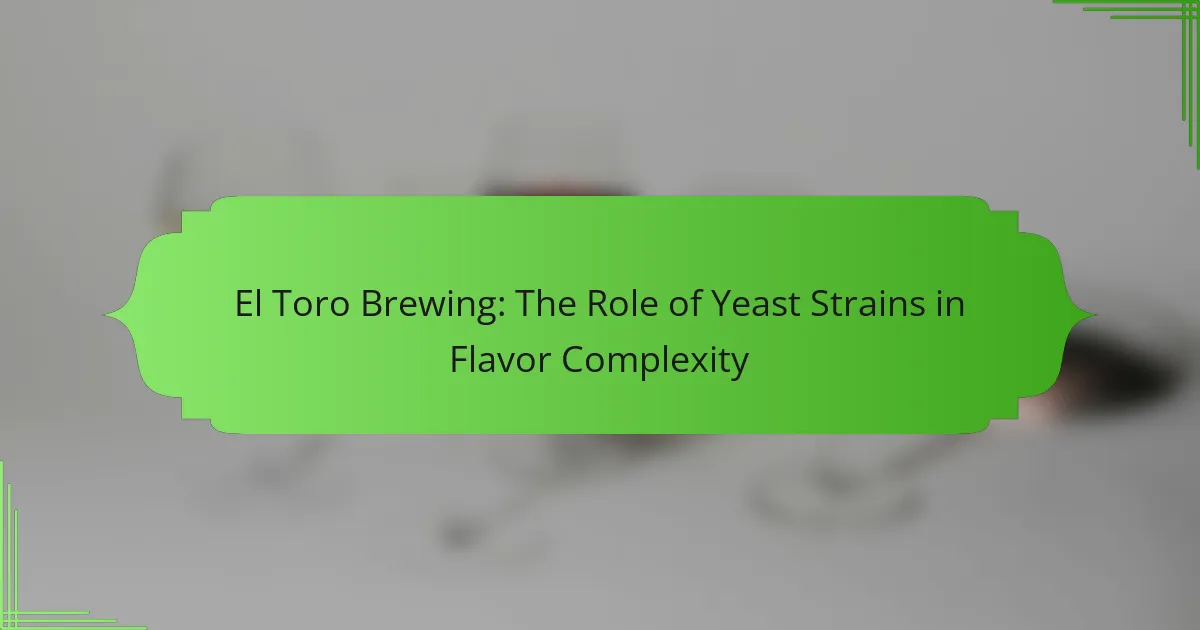El Toro Brewing is a craft brewery recognized for its innovative approach to yeast strains, which significantly enhances flavor complexity in beers. The brewery’s focus on experimenting with various yeast strains allows it to create unique flavor profiles that challenge traditional brewing methods. El Toro Brewing’s commitment to quality and creativity not only contributes to the craft beer movement but also inspires other brewers to explore new flavor possibilities. This article will explore the role of yeast strains in flavor complexity and how El Toro Brewing’s unique offerings have elevated the craft beer scene.

What is El Toro Brewing and its significance in the brewing industry?
El Toro Brewing is a craft brewery known for its innovative use of yeast strains. It plays a significant role in the brewing industry by enhancing flavor complexity in beers. The brewery focuses on experimenting with various yeast strains to develop unique flavor profiles. This approach has garnered attention for pushing the boundaries of traditional brewing practices. Additionally, El Toro Brewing contributes to the craft beer movement, emphasizing quality and creativity. Its commitment to yeast experimentation has influenced other brewers to explore new flavor possibilities. The brewery’s unique offerings have helped to elevate the craft beer scene.
How does El Toro Brewing define its unique approach to brewing?
El Toro Brewing defines its unique approach to brewing through a focus on innovative yeast strains. They select specific strains to enhance flavor complexity in their beers. This selection process allows them to create distinct taste profiles. The brewery emphasizes experimentation with fermentation techniques. They aim to push the boundaries of traditional brewing methods. By prioritizing yeast diversity, El Toro Brewing achieves unique flavor combinations. Their commitment to quality ingredients further supports this approach. This results in a product that stands out in the craft beer market.
What are the core values and mission of El Toro Brewing?
El Toro Brewing’s core values include quality, innovation, and community. Their mission is to craft exceptional beers that celebrate flavor and creativity. They prioritize using high-quality ingredients and traditional brewing methods. El Toro Brewing also emphasizes sustainability in their brewing practices. They aim to create a welcoming environment for beer enthusiasts. Community engagement is central to their operations. They often collaborate with local businesses and participate in community events. This commitment enhances their connection with customers and the local culture.
How does El Toro Brewing differentiate itself from other breweries?
El Toro Brewing differentiates itself through its unique yeast strains. These strains are specifically selected to enhance flavor complexity. The brewery focuses on experimental brewing techniques. This allows for innovative flavor profiles not commonly found in mainstream beers. El Toro Brewing also emphasizes small-batch production. This approach ensures quality and distinctive character in each brew. The brewery’s commitment to local ingredients further sets it apart. By sourcing locally, they create a connection with the community and enhance freshness.
What role do yeast strains play in the brewing process?
Yeast strains are essential in the brewing process as they ferment sugars to produce alcohol and carbon dioxide. Different yeast strains contribute unique flavors and aromas to the beer. For instance, ale yeast typically ferments at warmer temperatures, producing fruity esters. Lager yeast ferments at cooler temperatures, resulting in a cleaner taste. The choice of yeast strain impacts the final product’s mouthfeel and complexity. Studies show that specific strains can enhance hop flavors or add spiciness. Thus, selecting the right yeast strain is crucial for achieving desired flavor profiles in brewing.
How do yeast strains contribute to flavor complexity in beers?
Yeast strains contribute to flavor complexity in beers through the production of various metabolites. These metabolites include esters, phenols, and higher alcohols. Esters often impart fruity flavors, while phenols can provide spicy or clove-like notes. Different yeast strains produce these compounds in varying amounts, leading to distinct flavor profiles. For example, Saccharomyces cerevisiae typically generates more esters compared to other strains. Additionally, fermentation conditions such as temperature influence the flavor compounds produced. Higher fermentation temperatures can enhance ester production, adding to the complexity. Studies show that the choice of yeast can significantly alter the sensory characteristics of the final beer product. This variability is essential for brewers aiming to create unique and diverse beer styles.
What are the different types of yeast strains used by El Toro Brewing?
El Toro Brewing uses several types of yeast strains to enhance flavor complexity. Common strains include American Ale yeast, known for its clean and crisp profile. Belgian yeast strains are also utilized, providing fruity and spicy characteristics. Additionally, El Toro Brewing employs lager yeast for a smooth and refreshing taste. These yeast strains contribute significantly to the unique flavor profiles of their beers. Each strain is selected based on the desired outcome in brewing. The combination of these yeast strains allows for a diverse range of flavors in their beer offerings.
Why are yeast strains considered essential for flavor development?
Yeast strains are essential for flavor development because they produce various compounds during fermentation. These compounds include esters, phenols, and alcohols, which contribute to the overall flavor profile. Different yeast strains generate distinct flavor characteristics due to their unique metabolic pathways. For example, ale yeast strains often produce fruity esters, while lager yeast tends to create cleaner profiles. The fermentation temperature also influences the flavor compounds produced by yeast. Studies have shown that specific yeast strains can enhance desired flavors in beverages, making them crucial for brewers. Thus, the selection of yeast strains directly impacts the complexity and quality of the final product.
What chemical processes occur during fermentation with yeast strains?
Fermentation with yeast strains involves several key chemical processes. The primary process is glycolysis, where glucose is converted into pyruvate. This process occurs in the cytoplasm of yeast cells and generates ATP, which is energy for the yeast.
Following glycolysis, pyruvate undergoes fermentation, producing ethanol and carbon dioxide. This anaerobic process allows yeast to generate energy without oxygen. The production of ethanol is crucial for alcoholic beverages, while carbon dioxide contributes to carbonation.
Additionally, yeast strains can produce various byproducts during fermentation. These byproducts include esters and phenols, which contribute to the flavor and aroma of the final product. Different yeast strains can produce unique profiles due to their specific metabolic pathways.
Overall, the chemical processes during fermentation with yeast strains are essential for developing flavor complexity in brewing. These processes include glycolysis, alcoholic fermentation, and the production of flavor compounds.
How do yeast strains influence the aroma and taste profiles of beer?
Yeast strains significantly influence the aroma and taste profiles of beer. Different yeast strains produce varying amounts of esters and phenols during fermentation. Esters contribute fruity and floral notes, while phenols can add spicy or smoky flavors. For example, Saccharomyces cerevisiae, a common ale yeast, often produces banana and clove aromas. In contrast, lager yeasts like Saccharomyces pastorianus typically result in cleaner, crisper profiles. The fermentation temperature also affects these compounds; higher temperatures can enhance ester production. Research shows that specific yeast strains can be selected to create desired flavor characteristics in craft brewing. This selection process allows brewers to craft unique beer styles and profiles.
How does El Toro Brewing select its yeast strains for specific brews?
El Toro Brewing selects its yeast strains based on the desired flavor profile of each brew. The brewing team evaluates the specific characteristics needed for the beer style. They consider factors such as fermentation temperature, attenuation, and esters produced by the yeast. Each strain contributes unique flavors and aromas to the final product. The selection process involves testing various strains in pilot batches. Sensory evaluations are conducted to assess the impact on flavor. This method ensures that the chosen yeast enhances the overall complexity of the brew. The approach aligns with industry practices for optimal flavor development.
What criteria does El Toro Brewing use to evaluate yeast strains?
El Toro Brewing evaluates yeast strains based on fermentation characteristics, flavor profiles, and attenuation levels. Fermentation characteristics include the yeast’s ability to ferment sugars efficiently. Flavor profiles are assessed to determine how they contribute to the overall taste of the beer. Attenuation levels refer to the yeast’s capability to convert sugars into alcohol. Additionally, consistency and reliability of the yeast strain during brewing processes are crucial. These criteria ensure that the selected strains enhance flavor complexity and maintain quality in the final product.
How does the choice of yeast strain affect the final product?
The choice of yeast strain significantly affects the final product in brewing. Different yeast strains produce varying levels of alcohol, esters, and phenols. These compounds directly influence the flavor and aroma of the beer. For example, ale yeast typically ferments at warmer temperatures, resulting in fruity flavors. In contrast, lager yeast ferments at cooler temperatures, yielding a cleaner taste. Specific strains can also impart unique characteristics, such as spiciness or floral notes. Studies show that yeast contributes up to 70% of a beer’s flavor profile. Therefore, selecting the right yeast strain is crucial for achieving desired taste and complexity in the final product.
What challenges does El Toro Brewing face with yeast strain management?
El Toro Brewing faces several challenges with yeast strain management. These challenges include maintaining yeast viability and health throughout the brewing process. Yeast strains can exhibit different behaviors under varying fermentation conditions. This variability can lead to inconsistent flavor profiles in the final product. Additionally, contamination from wild yeast or bacteria can compromise the quality of the brew. Regular monitoring and adjustments are necessary to ensure optimal fermentation. Moreover, strain selection impacts the desired flavor complexity and aroma. Each yeast strain has unique fermentation characteristics that affect the brewing timeline. These factors collectively complicate effective yeast management for consistent output.
How do environmental factors impact yeast performance in brewing?
Environmental factors significantly impact yeast performance in brewing. Temperature is crucial; optimal ranges enhance fermentation rates. Excessive heat can lead to stress, producing off-flavors. Oxygen levels also influence yeast activity; adequate oxygen supports healthy growth. pH levels affect yeast metabolism; a balanced pH promotes efficient fermentation. Nutrient availability is essential; deficiencies can slow fermentation and alter flavor profiles. Additionally, the presence of inhibitors, such as certain chemicals, can hinder yeast performance. Research indicates that controlling these factors can improve beer quality and flavor complexity.
What are common issues that arise from yeast strain selection?
Common issues that arise from yeast strain selection include fermentation failure, off-flavors, and inconsistent product quality. Fermentation failure can occur if the selected yeast strain is not well-suited for the specific conditions of the brewing process. Off-flavors may develop when certain yeast strains produce unwanted byproducts during fermentation. Inconsistent product quality can result from variations in yeast performance, leading to different flavor profiles in each batch. These issues can ultimately impact the overall success of the brewing process and the final product.
What are the best practices for using yeast strains in brewing?
Use healthy yeast strains to ensure optimal fermentation. Healthy yeast contributes to consistent flavor profiles and fermentation efficiency. Maintain proper temperature control during fermentation. This prevents off-flavors and promotes desired yeast characteristics. Oxygen levels should be monitored to avoid oxidation. Proper aeration is crucial for yeast growth in the initial stages. Pitch the correct amount of yeast for the batch size. Under-pitching can lead to sluggish fermentation. Consider using yeast starters for increased viability. This practice enhances yeast health and fermentation speed. Select yeast strains suited for specific beer styles. Different strains impart unique flavors and aromas, influencing the final product. Regularly monitor fermentation progress. This helps identify any issues early on.
How can brewers optimize yeast health for better flavor outcomes?
Brewers can optimize yeast health by maintaining proper fermentation temperatures. This ensures that yeast remains active and healthy throughout the process. Additionally, providing adequate nutrients is crucial for yeast vitality. Nutrients such as nitrogen and vitamins support yeast growth and fermentation efficiency.
Regular monitoring of pH levels also contributes to yeast health. Maintaining a pH between 4.0 and 5.0 is ideal for most yeast strains. Oxygen levels should be carefully managed during fermentation. While yeast requires oxygen at the beginning, excessive oxygen can lead to off-flavors.
Using appropriate yeast strains for specific beer styles enhances flavor outcomes. Each strain has unique characteristics that influence the final product. Lastly, proper sanitation practices prevent contamination. Contaminants can stress yeast and negatively impact flavor. By implementing these strategies, brewers can achieve optimal yeast health and improve flavor complexity in their beers.
What tips can El Toro Brewing share for aspiring brewers regarding yeast strains?
El Toro Brewing recommends aspiring brewers to select yeast strains based on the desired flavor profile. Different yeast strains produce distinct flavors and aromas. For example, ale yeast typically offers fruity esters, while lager yeast provides a clean finish. Understanding fermentation temperature is crucial; higher temperatures can enhance fruity notes, while lower temperatures yield a crisper taste. Additionally, brewers should consider the yeast’s attenuation level, which affects the final sweetness of the beer. Regularly testing and experimenting with various strains can lead to unique creations. Lastly, maintaining proper sanitation practices ensures that yeast performs optimally without contamination.
El Toro Brewing is a craft brewery recognized for its innovative use of yeast strains to enhance flavor complexity in beers. The article explores how El Toro Brewing’s unique approach to yeast selection and fermentation techniques contributes to distinct taste profiles, setting it apart in the brewing industry. It also covers the brewery’s core values of quality, innovation, and community engagement, while detailing the role of yeast strains in flavor development, the challenges of yeast management, and best practices for optimizing yeast health. Additionally, insights are provided for aspiring brewers on selecting and experimenting with yeast strains to achieve desired flavor outcomes.


